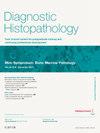Neoadjuvant chemo-immunotherapy in non-small cell lung cancer: clinical rationale and methods of pathological assessment
引用次数: 0
Abstract
Non-small cell lung cancer (NSCLC) remains a common cancer with poor outcomes, with even early stage, resectable tumours having a high recurrence rate. Over the past decade immunotherapy has been paradigm-changing in advanced, metastatic NSCLC while more recent evidence has demonstrated its important role as a neoadjuvant agent in surgically resectable disease. This has led to a significant shift in clinical practice and, in doing so, has altered requirements in the pathological assessment of surgical resection specimens. In this paper, we summarize the clinical, biological and pathological rationale behind neoadjuvant immunotherapy, describe the evidence base for this change in clinical practice and detail the central role of histopathology. Clinical trials have demonstrated marked event-free and overall survival advantages for combined immunotherapy and chemotherapy with pathological response an important surrogate marker of long-term outcome. We describe the key histopathological and molecular characteristics that render a patient eligible for neoadjuvant treatment as well as the requirements for assessment of surgical specimens to enable the accurate quantification of pathological response. In addition, the potential future roles for alternative measures of disease response are discussed, including circulating tumour DNA, immune cell phenotyping and artificial intelligence-based analyses.
非小细胞肺癌的新辅助化疗-免疫治疗:临床基础和病理评估方法
非小细胞肺癌(NSCLC)仍然是一种预后较差的常见癌症,即使是早期可切除的肿瘤也有很高的复发率。在过去的十年中,免疫疗法已经改变了晚期、转移性非小细胞肺癌的治疗模式,而最近的证据表明,免疫疗法作为一种新辅助药物在可手术切除的疾病中发挥了重要作用。这导致了临床实践的重大转变,并在此过程中改变了对手术切除标本病理评估的要求。在本文中,我们总结了新辅助免疫治疗背后的临床、生物学和病理学原理,描述了临床实践中这种变化的证据基础,并详细介绍了组织病理学的核心作用。临床试验已经证明了免疫治疗和化疗联合治疗的无事件和总体生存优势,病理反应是长期预后的重要替代指标。我们描述了使患者有资格接受新辅助治疗的关键组织病理学和分子特征,以及评估手术标本的要求,以便准确量化病理反应。此外,还讨论了疾病反应替代措施的潜在未来作用,包括循环肿瘤DNA,免疫细胞表型和基于人工智能的分析。
本文章由计算机程序翻译,如有差异,请以英文原文为准。
求助全文
约1分钟内获得全文
求助全文
来源期刊

Diagnostic Histopathology
Medicine-Pathology and Forensic Medicine
CiteScore
1.30
自引率
0.00%
发文量
64
期刊介绍:
This monthly review journal aims to provide the practising diagnostic pathologist and trainee pathologist with up-to-date reviews on histopathology and cytology and related technical advances. Each issue contains invited articles on a variety of topics from experts in the field and includes a mini-symposium exploring one subject in greater depth. Articles consist of system-based, disease-based reviews and advances in technology. They update the readers on day-to-day diagnostic work and keep them informed of important new developments. An additional feature is the short section devoted to hypotheses; these have been refereed. There is also a correspondence section.
 求助内容:
求助内容: 应助结果提醒方式:
应助结果提醒方式:


